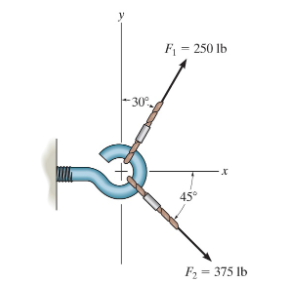
Elements Of Electromagnetics
7th Edition
ISBN: 9780190698614
Author: Sadiku, Matthew N. O.
Publisher: Oxford University Press
expand_more
expand_more
format_list_bulleted
Concept explainers
Question
Inspect F1 and F2 and write each force
x and y. Determine the magnitude of the resultant force vector, FR = F1 + F2. Lastly, calculate the
direction of FR, measured counterclockwise from the positive x axis.

Transcribed Image Text:-30°
F₁ = 250 lb
45°
·x
F₂-375 lb
Expert Solution
This question has been solved!
Explore an expertly crafted, step-by-step solution for a thorough understanding of key concepts.
Step by stepSolved in 3 steps with 12 images

Knowledge Booster
Learn more about
Need a deep-dive on the concept behind this application? Look no further. Learn more about this topic, mechanical-engineering and related others by exploring similar questions and additional content below.Similar questions
- 1 of 1 ure 300 lb 30 200 lb Type here to searcharrow_forwardNeed help with thisarrow_forwarddetermine the moment that is formed due F at the origin. you must use a SCALAR method. However express your final ansewr as a cartesian vector. The force vector of F & the lever are in the XY plane.arrow_forward
- Q1/ A-Given F1 -5.ON 30° N of E F2-7.0N 60° S of W and F3-10.0N 40° E of S. (a) Find the components of each vector. (b) Find the vector components of the resultant force . (c) Find the magnitude and direction of the resultant force.arrow_forwardThe plate is subjected to the two forces at A and B as shown. If 0 = 60°, determine the magnitude of the resultant of these two forces and its direction measured clockwise from the horizontal. Use the parallelogram law/triangle rule. T TI דה 1 m 100- 40⁰ A FA-8 KN Fn = 6 kN 1. Magnitude of FR in dynes (express in 4 significant figures). The unknown angle in radians (express in 4 significant figures). 2.arrow_forward7. The values of Rx = EFx. Ry= EFy, and EMO for five force systems lying in the xy-plane are listed in the following table. Point O is the origin of the coordinate system, and positive moments are counterclockwise. Determine the resultant for each force system, and show it on a sketch of the coordinate system. Part R. R, ΣΜο 1 250 N 450 N- m 250 N -450N. m 3 300 lb 450 lb 650 lb - ftarrow_forward
- Don't copy and complete solution pleasearrow_forwarda) Determine the coordinate direction angle each force makes with the coordinate axes (i.e. a1, B1, yı for F1 and a2, B2, y2 for F2) from the components of unit vectors acting in the direction of Fr and F2 (Note: Force F2 is on the yz-plane). Express F1 and F2 as Cartesian vectors. Check your results by calculating the magnitudes of each vector. F2 = 80 kN F, = 50 kN 5 15 30° 3 4 y b) Determine the angle 0 between forces F1 and F2: F2 = 80 kN F, = 50 kN %3D 5 15 30 3 4 y Determine the magnitudes of the projection of the force F onto the u and v axes, Fu and Fv, respectively. Also, determine the components perpendicular to the u and v axes, Ful and Fy1. (Note: The v-axis points vertically upward perpendicular to the surface to which the hook is bolted.) ul F= 50 N 15 n° 105arrow_forwardQ1. The bracket is subjected to the two forces shown. Express each force in Cartesian vector form and then determine the resultant force FR. Find the magnitude and direction cosines of the resultant force. 120 F₂ = 400 N F₁ = 250 Narrow_forward
arrow_back_ios
arrow_forward_ios
Recommended textbooks for you
 Elements Of ElectromagneticsMechanical EngineeringISBN:9780190698614Author:Sadiku, Matthew N. O.Publisher:Oxford University Press
Elements Of ElectromagneticsMechanical EngineeringISBN:9780190698614Author:Sadiku, Matthew N. O.Publisher:Oxford University Press Mechanics of Materials (10th Edition)Mechanical EngineeringISBN:9780134319650Author:Russell C. HibbelerPublisher:PEARSON
Mechanics of Materials (10th Edition)Mechanical EngineeringISBN:9780134319650Author:Russell C. HibbelerPublisher:PEARSON Thermodynamics: An Engineering ApproachMechanical EngineeringISBN:9781259822674Author:Yunus A. Cengel Dr., Michael A. BolesPublisher:McGraw-Hill Education
Thermodynamics: An Engineering ApproachMechanical EngineeringISBN:9781259822674Author:Yunus A. Cengel Dr., Michael A. BolesPublisher:McGraw-Hill Education Control Systems EngineeringMechanical EngineeringISBN:9781118170519Author:Norman S. NisePublisher:WILEY
Control Systems EngineeringMechanical EngineeringISBN:9781118170519Author:Norman S. NisePublisher:WILEY Mechanics of Materials (MindTap Course List)Mechanical EngineeringISBN:9781337093347Author:Barry J. Goodno, James M. GerePublisher:Cengage Learning
Mechanics of Materials (MindTap Course List)Mechanical EngineeringISBN:9781337093347Author:Barry J. Goodno, James M. GerePublisher:Cengage Learning Engineering Mechanics: StaticsMechanical EngineeringISBN:9781118807330Author:James L. Meriam, L. G. Kraige, J. N. BoltonPublisher:WILEY
Engineering Mechanics: StaticsMechanical EngineeringISBN:9781118807330Author:James L. Meriam, L. G. Kraige, J. N. BoltonPublisher:WILEY

Elements Of Electromagnetics
Mechanical Engineering
ISBN:9780190698614
Author:Sadiku, Matthew N. O.
Publisher:Oxford University Press

Mechanics of Materials (10th Edition)
Mechanical Engineering
ISBN:9780134319650
Author:Russell C. Hibbeler
Publisher:PEARSON

Thermodynamics: An Engineering Approach
Mechanical Engineering
ISBN:9781259822674
Author:Yunus A. Cengel Dr., Michael A. Boles
Publisher:McGraw-Hill Education

Control Systems Engineering
Mechanical Engineering
ISBN:9781118170519
Author:Norman S. Nise
Publisher:WILEY

Mechanics of Materials (MindTap Course List)
Mechanical Engineering
ISBN:9781337093347
Author:Barry J. Goodno, James M. Gere
Publisher:Cengage Learning

Engineering Mechanics: Statics
Mechanical Engineering
ISBN:9781118807330
Author:James L. Meriam, L. G. Kraige, J. N. Bolton
Publisher:WILEY